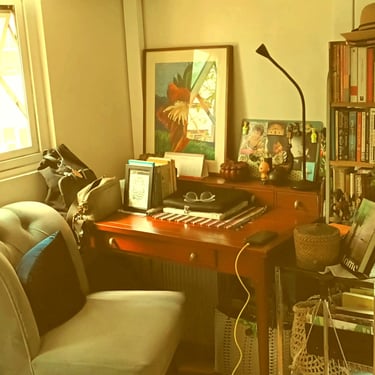What Makes a Page-Turner? Close Reading of Sample Quotes from Books That Are Hard to Put Down
READING AT WORDHOUSEWORKSHOP


The Hook: Grabbing Attention from the First Sentence
The opening line or paragraph of a book is critical in setting the tone and capturing the reader's attention. A compelling start not only draws readers into the narrative but also establishes an immediate connection between the reader and the story. This hook, often laden with mystery, intrigue, or striking language, is a hallmark of books that are hard to put down.
Take, for instance, the iconic first line from George Orwell's "1984": "It was a bright cold day in April, and the clocks were striking thirteen." This sentence introduces a world slightly askew from our own, provoking curiosity and setting a dystopian tone that promises an intriguing journey.
Similarly, in J.K. Rowling's "Harry Potter and the Philosopher's Stone," the opening sentence reads: "Mr. and Mrs. Dursley, of number four, Privet Drive, were proud to say that they were perfectly normal, thank you very much." This line subtly hints at the extraordinary events to come, contrasting the prosaic life of the Dursleys with the magical undertones awaiting the reader.
Authors also employ concise, evocative language to hook their audience. In the opening of Rudyard Kipling's "The Jungle Book": "It was seven o’clock of a very warm evening in the Seeonee hills when Father Wolf woke up from his day’s rest, scratched himself, yawned, and spread out his paws one after the other to get rid of the sleepy feeling in their tips." This description immerses the reader in the story’s exotic setting while introducing a character that feels both relatable and fascinating.
Whether through a puzzling detail, a promise of adventure, or a richly painted scene, the opening of a narrative primes the reader for the journey ahead. Across genres, the common thread is the author's skill in crafting an opening that is so intriguing, it demands the reader's attention and compels them to read on.
Building Suspense and Maintaining Tension
Suspense and tension are pivotal elements in creating a page-turner, often achieved through a combination of pacing, cliffhangers, character dilemmas, and plot twists. These narrative techniques are meticulously woven into the fabric of the story to keep readers on the edge of their seats, unwilling to put the book down.
Pacing is fundamental in generating suspense. It involves the speed at which a story unfolds, allowing authors to control the reader's heartbeat. In Gillian Flynn's "Gone Girl," alternating perspectives create a relentless push and pull: "I was told love should come with a warning. The moment we met, a clock was started that reached its end fifteen years later." The calculated tempo heightens the suspense as revelations emerge slowly, maintaining a constant tension.
Cliffhangers are another effective tool, often utilized at the end of chapters or sections to compel readers to keep going. Consider the ending of a chapter in "The Da Vinci Code" by Dan Brown: "Everyone loves a conspiracy." This simple line invites myriad questions, urging the reader to seek answers in the following pages. The suspense lies in the unknown, in the critical information withheld just out of reach.
Character dilemmas further deepen the reader’s investment. When characters face impossible choices or high-stakes situations, their struggles translate to the reader's engagement. In J.K. Rowling's "Harry Potter and the Sorcerer's Stone," Harry’s internal debate about whether to pursue clues about the Philosopher's Stone is a compelling instance: "It does not do to dwell on dreams and forget to live."
Plot twists are the ultimate game-changer, redefining the storyline’s direction and heightening suspense. In "The Girl on the Train" by Paula Hawkins, a pivotal twist leaves readers reeling: "I have lost control of everything. Even the places in my head." This stark revelation shifts the narrative’s entire perspective, keeping the reader glued to the pages.
Through masterful pacing, strategic cliffhangers, intricate character dilemmas, and explosive plot twists, authors craft a layered tapestry of tension, ensuring readers remain captivated. Each element serves as a finely tuned instrument in the orchestra of suspense that characterizes a true page-turner.
Characterization and Emotional Connection
The art of creating a page-turning book is influenced by the depth and complexity of its characters. Readers are drawn to stories where they can form a strong emotional connection with the characters, feeling as though they are part of their journey. This emotional investment is often fostered through multidimensional characterizations that demonstrate relatable traits, internal conflicts, and significant growth over the course of the narrative.
One method authors use to build these emotional ties is through dialogue. Conversations between characters reveal not only plot details but also the characters' personalities, motivations, and inner struggles. For instance, in J.K. Rowling's "Harry Potter" series, the dialogue between Harry and his friends often encapsulates their fears, hopes, and loyalty, making readers empathize with their collective journey.
Internal monologues also play a crucial role in deepening the emotional resonance of characters. By providing a window into their thoughts and feelings, authors allow readers to form a more intimate connection with them. Consider Jane Austen's "Pride and Prejudice," where Elizabeth Bennet's introspective moments help readers understand her pride, prejudices, and eventual transformation, thereby making her a compelling and relatable character.
Interactions between characters further solidify these emotional connections. Moments of conflict, bonding, and growth, exemplified through actions and reactions, create a dynamic rather than static storytelling environment. In Khaled Hosseini's "The Kite Runner," the friendship and eventual betrayal between Amir and Hassan anchor the emotional core of the story, urging readers to turn the pages to uncover their fates.
In Charlotte Brontë's "Jane Eyre," Jane's declaration, “I am no bird; and no net ensnares me: I am a free human being with an independent will,” resonates with readers because it encapsulates her spirit and determination.
By crafting characters that readers can relate to, care about, and root for, authors create a narrative propulsion that makes a book hard to put down. The adept use of dialogue, internal monologues, and character interactions draw the readers into a vivid and emotionally engaging world.
Have you encountered any reading material that challenged you because of its style or approach? Reading is more than just entertainment for a writer. It's a masterclass in storytelling. Study a structure for your prose, be deliberate in your choices.

Featuring LibroBisa, our close reading of well-read books in Librokoto. First, us, then our immediate reviewers, and then you! Experience the impact of these literary gems.
LIBROBISA

Discover Filipiniana in Librokoto. Engaging and informative reviews accompany our appreciation of many cherished books in the Wordhouse Book Shelf.
LIBROKOTO



